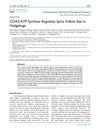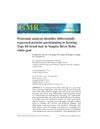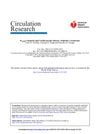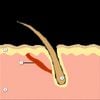Search
forLearn
1 / 1 resultsResearch
5 / 1000+ results
research COX2-ATP Synthase Regulates Spine Follicle Size in Hedgehogs
COX2 and ATP synthase control the size of hedgehog spines.
research Mechanism of Action of Minoxidil in the Treatment of Androgenetic Alopecia Is Likely Mediated by Mitochondrial Adenosine Triphosphate Synthase-Induced Stem Cell Differentiation
Minoxidil helps hair growth by promoting stem cell differentiation through increased ATP synthase activity.

research Proteomic Analysis Identifies Differentially Expressed Proteins Participating in Forming Type III Brush Hair in Yangtze River Delta White Goat
Researchers found four key proteins that affect the development of a specific hair type in Yangtze River Delta white goats.

research Effects of Adenosine Triphosphate on Vandetanib-Induced Skin Damage in Rats
ATP helps prevent skin damage from vandetanib by reducing stress.

research K ATP Channels and Cardiovascular Disease
K_ATP channel gene mutations are linked to heart diseases, but more research is needed to understand the connection and treatment potential.
Community Join
5 / 90 resultscommunity 30-Min Dermatology Visit – Best Questions to Ask About Balding? ( 175$ )
The conversation discusses hair loss treatments, focusing on finasteride, minoxidil, and other options like PRP and ketoconazole. It highlights the importance of asking specific questions during a dermatology visit to determine the cause of hair loss and appropriate treatments.
community Physio-metabolic method of treating androgenic alopecia. Cold receptors. The relationship between DHT, cold receptors, minoxidil and antiandrogens.
A method for treating androgenic alopecia using minoxidil, antiandrogens, exercise, and cold exposure to promote hair growth. Environmental factors and lifestyle changes, like diet and exercise, can improve treatment effectiveness.

community Physio-metabolic method of treating androgenic alopecia. Cold receptors. The relationship between DHT, cold receptors, minoxidil and antiandrogens
Treating androgenic alopecia with minoxidil, finasteride, and antiandrogens, alongside exercise, cryotherapy, and natural substances to stimulate cold receptors for better hair growth. The method focuses on enhancing treatment effectiveness by considering environmental and behavioral factors and the role of cold receptors and muscle stress.
community Creatine is the opposite of minoxidil !
Creatine may counteract minoxidil's hair growth effects by closing potassium ATP channels, potentially leading to hair loss in predisposed individuals. Despite anecdotal reports, there is no conclusive evidence linking creatine to hair loss.
community Il PP405 è molto promettente ma non è l'unico in grado di liberarci dalla iattura
PP405 shows promise in hair loss treatment, but stem cell therapy using adipose-derived stem cells and ATP also successfully reversed androgenetic alopecia in mice. Stem cell therapy is costly, and some doubt the effectiveness of PP405 based on press releases.